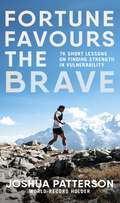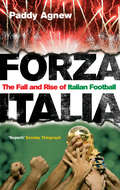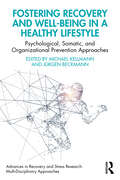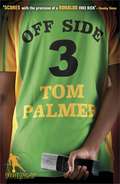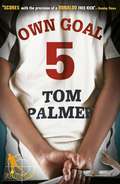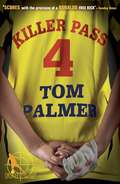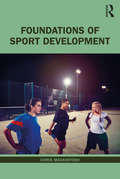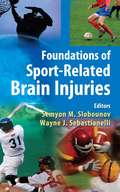- Table View
- List View
Fortune and the Golden Trophy (Pony Club Secrets #7)
by Stacy GreggThe seventh gripping adventure in this exciting pony-club series. With gymkhanas to win, rivals to defeat, mysteries to solve and ponies in danger to save – these books are perfect for all girls who love ponies.
Fortune Favours the Brave: 76 Short Lessons on Finding Strength in Vulnerability
by Joshua PattersonWhether you are struggling with self-doubt or lacking purpose, these 76 short motivational lessons from the multiple world-record holder, Josh Patterson, will give you the boost you need.When Josh set out to break the world record and run 76 marathons around the UK’s 76 cities in 76 days he knew it would be a test of determination and resilience, but he hadn't realised that his past struggles would provide the real strength he needed to cross the finish line. Having suffered with depression and come close to suicide in the past, Josh ran to raise money for the Samaritans and as he ran through the wind and rain, sometimes with crowds of supporters, sometimes alone, he often drew upon the memories of his darkest days to spur him on, knowing that there were happier times ahead. This is a collection of the 76 powerful lessons that fuelled Josh to reach the finish line – and will inspire you to reach yours, whatever that might look like – including:Memories are motivationThere is no such thing as failure, only a lesson to be learnedDon’t be too proud to ask for helpLook at how far you’ve comeFocus on progress over perfectionYour thoughts don’t define you This isn't a book about running, it is about how to find light in the dark and rise from the ashes, and how to find the strength to achieve whatever you put your mind to.
Forward bend - sitting yoga posture (Large Print)
by Rnib BookshareThis image can only give an insight into what yoga is. It cannot be used alone as a training / user guide. The posture is only one from hundreds of possibilities and cannot be used in isolation. Yoga must be taught with breathing exercises and sequencing of postures. Each posture involves a timed procedure of movement, breathing and focused thought, not a static exercise position. There are two images of a seated woman seen from the side, separated by a dashed line on the page. There is a locator dot shown which will be in the top left of the page when the image is the correct way up. The image at the top of the page is the full sitting, forward bend posture. The woman wears a vest and leggings. Only one leg and arm are shown. The woman's bottom is to the left and her feet to the right of the page. Her upper body is sharply bent at the hips towards the right. Her arms stretch forward to the right and her hands grasp her feet. Her legs are straight. Her head is between her arms so the middle of her head cannot be found. Most of her face is also hidden by her lower legs as she faces the floor. Her hair is tied up in a bun. The image at the bottom of the page is the easy or beginner's sitting, forward bend posture. The woman also wears a vest and leggings. Only one leg and arm are shown. The woman's bottom is to the left and her feet to the right of the page. Her upper body is bent at the hips and she leans towards the right. Her arms stretch forward to the right and her hands grasp her feet. Her legs are bent slightly at the knee as she looks at her feet. Her hair is tied up in a bun.
Forward bend - sitting yoga posture (UEB Contracted)
by Rnib BookshareThis image can only give an insight into what yoga is. It cannot be used alone as a training / user guide. The posture is only one from hundreds of possibilities and cannot be used in isolation. Yoga must be taught with breathing exercises and sequencing of postures. Each posture involves a timed procedure of movement, breathing and focused thought, not a static exercise position. There are two images of a seated woman seen from the side, separated by a dashed line on the page. There is a locator dot shown which will be in the top left of the page when the image is the correct way up. The image at the top of the page is the full sitting, forward bend posture. The woman wears a vest and leggings. Only one leg and arm are shown. The woman's bottom is to the left and her feet to the right of the page. Her upper body is sharply bent at the hips towards the right. Her arms stretch forward to the right and her hands grasp her feet. Her legs are straight. Her head is between her arms so the middle of her head cannot be found. Most of her face is also hidden by her lower legs as she faces the floor. Her hair is tied up in a bun. The image at the bottom of the page is the easy or beginner's sitting, forward bend posture. The woman also wears a vest and leggings. Only one leg and arm are shown. The woman's bottom is to the left and her feet to the right of the page. Her upper body is bent at the hips and she leans towards the right. Her arms stretch forward to the right and her hands grasp her feet. Her legs are bent slightly at the knee as she looks at her feet. Her hair is tied up in a bun.
Forward bend - sitting yoga posture (UEB Uncontracted)
by Rnib BookshareThis image can only give an insight into what yoga is. It cannot be used alone as a training / user guide. The posture is only one from hundreds of possibilities and cannot be used in isolation. Yoga must be taught with breathing exercises and sequencing of postures. Each posture involves a timed procedure of movement, breathing and focused thought, not a static exercise position. There are two images of a seated woman seen from the side, separated by a dashed line on the page. There is a locator dot shown which will be in the top left of the page when the image is the correct way up. The image at the top of the page is the full sitting, forward bend posture. The woman wears a vest and leggings. Only one leg and arm are shown. The woman's bottom is to the left and her feet to the right of the page. Her upper body is sharply bent at the hips towards the right. Her arms stretch forward to the right and her hands grasp her feet. Her legs are straight. Her head is between her arms so the middle of her head cannot be found. Most of her face is also hidden by her lower legs as she faces the floor. Her hair is tied up in a bun. The image at the bottom of the page is the easy or beginner's sitting, forward bend posture. The woman also wears a vest and leggings. Only one leg and arm are shown. The woman's bottom is to the left and her feet to the right of the page. Her upper body is bent at the hips and she leans towards the right. Her arms stretch forward to the right and her hands grasp her feet. Her legs are bent slightly at the knee as she looks at her feet. Her hair is tied up in a bun.
Forward bend - standing, legs wide yoga posture (Large Print)
by Rnib BookshareThis image can only give an insight into what yoga is. It cannot be used alone as a training / user guide. The posture is only one from hundreds of possibilities and cannot be used in isolation. Yoga must be taught with breathing exercises and sequencing of postures. Each posture involves a timed procedure of movement, breathing and focused thought, not a static exercise position. There are two images of a standing woman, separated by a dashed line on the page. There is a locator dot shown which will be in the top left of the page when the image is the correct way up. The image on the top of the page is the full forward bend standing, legs wide posture. The woman wears a vest and leggings. She bends at the hip so her lower body faces forward and her upper body faces backwards. Her bottom is to the top and her feet to the bottom left and right of the page. Her legs are straight and go diagonally down to the left and right of the image. Her upper body hangs down vertically in the centre of the image. Her arms are bent and touch the floor to the left and right of her head in the bottom centre of the image. Her head does not quite touch the floor. She is looking backwards so her face cannot be found. Her hair is tied up in a bun. The image on the bottom of the page is the easy or beginner's forward bend standing, legs wide posture. The woman also wears a vest and leggings. She is seen from a three quarter view, so some of her front and some of her side on the right of the image are seen at the same time. Her bottom is to the top right and her feet to the bottom left and right of the page. Her upper body bent at the hips, goes diagonally down, forwards and left. Her arms stretch out diagonally down left and right. The upper arm to the left is hidden by the back of her head. She grasps her shins and looks at the floor so her face cannot be found. Her legs are straight. Her hair is tied up in a bun.
Forward bend - standing, legs wide yoga posture (UEB Contracted)
by Rnib BookshareThis image can only give an insight into what yoga is. It cannot be used alone as a training / user guide. The posture is only one from hundreds of possibilities and cannot be used in isolation. Yoga must be taught with breathing exercises and sequencing of postures. Each posture involves a timed procedure of movement, breathing and focused thought, not a static exercise position. There are two images of a standing woman, separated by a dashed line on the page. There is a locator dot shown which will be in the top left of the page when the image is the correct way up. The image on the top of the page is the full forward bend standing, legs wide posture. The woman wears a vest and leggings. She bends at the hip so her lower body faces forward and her upper body faces backwards. Her bottom is to the top and her feet to the bottom left and right of the page. Her legs are straight and go diagonally down to the left and right of the image. Her upper body hangs down vertically in the centre of the image. Her arms are bent and touch the floor to the left and right of her head in the bottom centre of the image. Her head does not quite touch the floor. She is looking backwards so her face cannot be found. Her hair is tied up in a bun. The image on the bottom of the page is the easy or beginner's forward bend standing, legs wide posture. The woman also wears a vest and leggings. She is seen from a three quarter view, so some of her front and some of her side on the right of the image are seen at the same time. Her bottom is to the top right and her feet to the bottom left and right of the page. Her upper body bent at the hips, goes diagonally down, forwards and left. Her arms stretch out diagonally down left and right. The upper arm to the left is hidden by the back of her head. She grasps her shins and looks at the floor so her face cannot be found. Her legs are straight. Her hair is tied up in a bun.
Forward bend - standing, legs wide yoga posture (UEB Uncontracted)
by Rnib BookshareThis image can only give an insight into what yoga is. It cannot be used alone as a training / user guide. The posture is only one from hundreds of possibilities and cannot be used in isolation. Yoga must be taught with breathing exercises and sequencing of postures. Each posture involves a timed procedure of movement, breathing and focused thought, not a static exercise position. There are two images of a standing woman, separated by a dashed line on the page. There is a locator dot shown which will be in the top left of the page when the image is the correct way up. The image on the top of the page is the full forward bend standing, legs wide posture. The woman wears a vest and leggings. She bends at the hip so her lower body faces forward and her upper body faces backwards. Her bottom is to the top and her feet to the bottom left and right of the page. Her legs are straight and go diagonally down to the left and right of the image. Her upper body hangs down vertically in the centre of the image. Her arms are bent and touch the floor to the left and right of her head in the bottom centre of the image. Her head does not quite touch the floor. She is looking backwards so her face cannot be found. Her hair is tied up in a bun. The image on the bottom of the page is the easy or beginner's forward bend standing, legs wide posture. The woman also wears a vest and leggings. She is seen from a three quarter view, so some of her front and some of her side on the right of the image are seen at the same time. Her bottom is to the top right and her feet to the bottom left and right of the page. Her upper body bent at the hips, goes diagonally down, forwards and left. Her arms stretch out diagonally down left and right. The upper arm to the left is hidden by the back of her head. She grasps her shins and looks at the floor so her face cannot be found. Her legs are straight. Her hair is tied up in a bun.
Forza Italia: The Fall and Rise of Italian Football
by Paddy AgnewWhen journalist Paddy Agnew and his girlfriend Dympna touched down in Rome in 1985 in search of adventure, sunshine and the soul of Italian football (well, Paddy was looking for that), they were travelling into the uncharted terrain of a country they did not know and a language they did not speak.It soon became clear that neither Italy nor Italian football would be boring. In that first week in Italy, Michel Platini and Juventus won the Intercontinental Cup, whilst just days later the PLO killed 13 people in a random shooting at Rome's Fiumicino airport. Paddy covered both stories. The coming years saw the rise of TV tycoon Silvio Berlusconi, as he became owner of AC Milan and then Prime Minister of Italy, naming his political party 'Forza Italia' after a football chant. In that same period, Argentine Diego Maradona became the uncrowned King of Naples, leading Napoli to a first ever Scudetto title in 1987, notwithstanding a hectic, Hollywood-esque lifestyle that mixed footballing genius with off-the-field excess.Forza Italia is a fascinating tale of inspired players, skilled coaches, rich tycoons, glitzy media coverage, Mafia corruption, allegations of drug taking and fan power - culminating in the 2006 World Cup victory that delighted a nation and a match-fixing scandal that shocked the world. It is also a personalised reflection on the consistent and continuing excellence of Italian football throughout a period of huge social, political and economic upheaval, offering a unique insight into a society where football has always been much more than just a game.
Fostering Recovery and Well-being in a Healthy Lifestyle: Psychological, Somatic, and Organizational Prevention Approaches (Advances in Recovery and Stress Research)
by Michael Kellmann Jürgen BeckmannThis insightful book addresses recovery as a comprehensive concept for prevention of health-threats in modern societies through active lifestyles. Several areas of society are addressed, such as sports, work environments, and the military. Internationally renowned experts from different scientific disciplines present results of empirical research as well as applied intervention techniques to effectively manage stress and promote recovery in healthy lifestyles.Recognizing the systemic nature of stress and recovery is critical to designing effective interventions and policies. By promoting a balance between stress and recovery in physiological, psychological, and social terms, individuals and societies can build resilience, promote optimal well-being, and mitigate the negative effects of chronic stress. This book focuses on key research in the area of recovery and healthy living and addresses psychological, somatic and organizational prevention strategies that foster recovery and healthy lifestyles in society. It offers an expanded understanding of recovery in the health field and applies this to different areas, such as the workplace.Though written for the scientific community, the book will also benefit applied health scientists, instructors, and students, as well as readers interested in applying effective well-being and recovery techniques in their own lives.
Fostering Recovery and Well-being in a Healthy Lifestyle: Psychological, Somatic, and Organizational Prevention Approaches (Advances in Recovery and Stress Research)
This insightful book addresses recovery as a comprehensive concept for prevention of health-threats in modern societies through active lifestyles. Several areas of society are addressed, such as sports, work environments, and the military. Internationally renowned experts from different scientific disciplines present results of empirical research as well as applied intervention techniques to effectively manage stress and promote recovery in healthy lifestyles.Recognizing the systemic nature of stress and recovery is critical to designing effective interventions and policies. By promoting a balance between stress and recovery in physiological, psychological, and social terms, individuals and societies can build resilience, promote optimal well-being, and mitigate the negative effects of chronic stress. This book focuses on key research in the area of recovery and healthy living and addresses psychological, somatic and organizational prevention strategies that foster recovery and healthy lifestyles in society. It offers an expanded understanding of recovery in the health field and applies this to different areas, such as the workplace.Though written for the scientific community, the book will also benefit applied health scientists, instructors, and students, as well as readers interested in applying effective well-being and recovery techniques in their own lives.
Fostering the Mental Health of Athletes, Coaches, and Staff: A Systems Approach to Developing a Mentally Healthy Sport Organization
by Charles A. MaherThis book describes a systems approach for fostering the mental health of athletes, coaches, and staff in sport organizations at professional, collegiate, and secondary school levels. Through this approach, readers can collaborate effectively with a range of professionals in sport organizations, helping to create a mentally healthy entity. Fostering the Mental Health of Athletes, Coaches, and Staff includes a set of sequential, interrelated chapters that detail precise steps along with practitioner exercises. Following an introductory chapter about the evolution of mental health in sport organizations, the systems approach is overviewed in terms of its constituent dimensions. Chapter-by-chapter guidance then is provided about the following activities: Creating a vision and direction for mental health in a sport organization. Assessing the readiness of a sport organization for mental health initiatives. Identifying and involving people as key contributors to mental health. Assessing the mental and emotional development of athletes, coaches, and staff. Designing and implementing mental health programs and services. Educating and training coaches, staff, and administrators about mental health. Establishing a team environment conducive to mental health. Formulating and enacting mental health policies, plans, and procedures. Coordinating mental skills, life skills, and mental health. Evaluating mental health programs and services. Making decisions about improving mental health initiatives. Through its unique and important nature and scope, as well as being the first of its kind to discuss athlete mental health through this specific lens, this book is essential for licensed sport, clinical, and counseling psychologists, as well as other professionals who communicate and collaborate regarding mental health, including mental performance consultants, athletic trainers, and administrators.
Fostering the Mental Health of Athletes, Coaches, and Staff: A Systems Approach to Developing a Mentally Healthy Sport Organization
by Charles A. MaherThis book describes a systems approach for fostering the mental health of athletes, coaches, and staff in sport organizations at professional, collegiate, and secondary school levels. Through this approach, readers can collaborate effectively with a range of professionals in sport organizations, helping to create a mentally healthy entity. Fostering the Mental Health of Athletes, Coaches, and Staff includes a set of sequential, interrelated chapters that detail precise steps along with practitioner exercises. Following an introductory chapter about the evolution of mental health in sport organizations, the systems approach is overviewed in terms of its constituent dimensions. Chapter-by-chapter guidance then is provided about the following activities: Creating a vision and direction for mental health in a sport organization. Assessing the readiness of a sport organization for mental health initiatives. Identifying and involving people as key contributors to mental health. Assessing the mental and emotional development of athletes, coaches, and staff. Designing and implementing mental health programs and services. Educating and training coaches, staff, and administrators about mental health. Establishing a team environment conducive to mental health. Formulating and enacting mental health policies, plans, and procedures. Coordinating mental skills, life skills, and mental health. Evaluating mental health programs and services. Making decisions about improving mental health initiatives. Through its unique and important nature and scope, as well as being the first of its kind to discuss athlete mental health through this specific lens, this book is essential for licensed sport, clinical, and counseling psychologists, as well as other professionals who communicate and collaborate regarding mental health, including mental performance consultants, athletic trainers, and administrators.
Foucault, Sport and Exercise: Power, Knowledge and Transforming the Self
by Pirkko Markula-Denison Richard PringleMichel Foucault’s work profoundly influences the way we think about society, in particular how we understand social power, the self, and the body. This book gives an innovative and entirely new analysis of is later works making it a one-stop guide for students, exploring how Foucauldian theory can inform our understanding of the body, domination, identity and freedom as experienced through sport and exercise. Divided into three themed parts, this book considers: Foucault’s ideas and key debates Foucault’s theories to explore power relations, the body, identity and the construction of social practices in sport and exercise how individuals make sense of the social forces surrounding them, considering physical activity, fitness and sport practices as expressions of freedom and sites for social change. Accessible and clear, including useful case studies helping to bring the theory to real-life, Foucault, Sport and Exercise considers cultures and experiences in sports, exercise and fitness, coaching and health promotion. In addition to presenting established Foucauldian perspectives and debates, this text also provides innovative discussion of how Foucault’s later work can inform the study and understanding of sport and the physically active body.
Foucault, Sport and Exercise: Power, Knowledge and Transforming the Self
by Pirkko Markula-Denison Richard PringleMichel Foucault’s work profoundly influences the way we think about society, in particular how we understand social power, the self, and the body. This book gives an innovative and entirely new analysis of is later works making it a one-stop guide for students, exploring how Foucauldian theory can inform our understanding of the body, domination, identity and freedom as experienced through sport and exercise. Divided into three themed parts, this book considers: Foucault’s ideas and key debates Foucault’s theories to explore power relations, the body, identity and the construction of social practices in sport and exercise how individuals make sense of the social forces surrounding them, considering physical activity, fitness and sport practices as expressions of freedom and sites for social change. Accessible and clear, including useful case studies helping to bring the theory to real-life, Foucault, Sport and Exercise considers cultures and experiences in sports, exercise and fitness, coaching and health promotion. In addition to presenting established Foucauldian perspectives and debates, this text also provides innovative discussion of how Foucault’s later work can inform the study and understanding of sport and the physically active body.
Foul Bottoms: The Pitfalls of Boating and How to Enjoy Them
by John QuirkBased on a series of highly popular articles written for Classic Boat magazine, this witty collection dwells on the scrapes people get themselves into when building and sailing boats of all descriptions. Most sailors will find something to relate to in the escapades and faux pas detailed here, and the stories will undoubtedly bring a wry smile to any boater's lips. John Quirk's terrifically witty cartoons help bring these anecdotes to life.Some quotes from the book:Her jeans fitted like the fuzz on a peach.With the horror of watching a hedgehog run amok in a condom factory.With the ship sinking beneath us, the owner frantically fumbled through the warranty.We hit the dining room with the etiquette of escaped lab rats.'Quirky is the sea-going version of Bill Bryson and Jeremy Clarkson - and he draws better!' - Dan Houston, Editor of Classic Boat
Foul Play: Off Side
by Tom PalmerWhen Danny Harte finds out there's been an anonymous foreign buy-out of his favourite club, City, he's furious - the fans were about to buy it themselves. The club is being secretive and Danny is determined to find out what's going on - until he's caught staking out the club by the police and cautioned. His parents are furious, and his friends too. No one is talking to him.But when Danny discovers Adam, a kid from Ghana, dumped by his agent who'd promised him a place as a junior at City, and lost in a foreign country he knows nothing about, Danny realizes there are worse ways of being alone. He decides to take Adam's story to the press - with terrifying consequences for them both . . .
Foul Play: Own Goal (Foul Play)
by Tom PalmerMeet Danny Harte.Football fan and crime detective.Danny loves supporting his local team, City FC. So when everyone starts supporting the Italian team Forza FC, Danny is angry. His club is in jeopardy and needs their support. Danny decides to investigate the sudden popularity of the new team - starting with Forza's billionaire owner - and that's when the danger really kicks off. . . Can Danny uncover the sinister reasons behind Forza's success - and save City at the same time?
Foul Play: Killer Pass
by Tom PalmerIn recent months there has been a spate of burglaries at the houses of players from Danny's favourite football club, City FC. Danny wants to know who's behind it all and is on the case. But after scouting out the crime scenes, there are newspaper reports of a young boy having been seen hanging around. Danny needs to find out who's behind these crimes - and fast. If he doesn't, he might have turned from crime detective into the biggest suspect of them all...
Foul Play: Tom Palmer (Foul Play Ser.)
by Tom PalmerDanny is obsessed with two things: football – especially City Football Club – and investigating crimes. So when England and City footballing hero Sam Roberts is reported missing the day after Danny saw him being taken, blindfolded, into the bowels of the City FC stadium late at night, he's determined to get to the bottom of it. But is Danny getting into something he can't handle?
Foul Play: Dead Ball (Foul Play #3)
by Tom PalmerRussian billionaire Dmitri Tupolev and a mystery Englishman agree to fix an important match in Russia's favour by intimidating the England goalie, Alex Finn. But Alex goes against their wishes. His punishment: an 'accidental' car crash and he's out of the return game in Russia. Something is going on with England's replacement goalie, and Danny soon finds himself caught up with the criminals of the footballing underworld. Will he unravel the match-fixing mystery?
Foul Play: The Dark Arts of Cheating in Sport
by Mike RowbottomFoul Play dissects the age-old subject of cheating in all its absurdity. From plain old doping to claiming a marathon victory despite having driven the middle section of the race, from match-fixing to diving for a penalty - cheating in sport is as old as sport itself. There are plenty of well-known cases of cheats being found out in sport: Ben Johnson, for example, was stripped of his 100m Olympic medal after a positive drugs test; South African cricketer Hansie Cronje was banned from all cricket for life after admitting involvement in match-rigging; rugby union recently found itself having to deal with the "bloodgate" scandal. However, there are myriad other examples of bending the rules more subtly: pressuring the referee, demoralising an opponent with mind games, or shirt-pulling.But what constititues cheating and where do we draw the line? Are some sports cleaner than others? Is cheating in one sport the same as cheating in another or does each sport's distinctive culture set different standards? Is there such a thing as a sport without sin? Or, indeed, a sporting competitor?This book is not a catalogue of past sporting misdemeanours so much as an investigation into the lengths to which some sports people have gone, and will go, to get the better of others. And also the lengths to which they will not go.
Foundations of Sport Development
by Chris MackintoshOffering a complete introduction to sport development policy and practice, this book covers key theory, themes, issues, and debates in sport development, without assuming any prior knowledge on the part of the reader. It outlines the organisational landscape of sport in the UK and explains important differences across England, Scotland, Wales, and Northern Ireland, as well as the global context. Examining both community and elite sport, it covers public, private, and third sectors, including national and local government and national governing bodies, and considers change – cultural, managerial, social, and political – as an element of sport development policy, strategy, and operations. Every chapter includes an in-depth case study around which a seminar or tutorial can be based, as well as definitions of key concepts and terminology that students and practitioners are likely to encounter during their studies or professional practice. Questions at the end of each chapter encourage the reader to reflect on their own work, and useful guides to further reading make the book an ideal jumping off point for further study. This is the perfect foundation textbook for any sport development course taken as part of a degree program in sport development, sport management, or sport coaching.
Foundations of Sport Development
by Chris MackintoshOffering a complete introduction to sport development policy and practice, this book covers key theory, themes, issues, and debates in sport development, without assuming any prior knowledge on the part of the reader. It outlines the organisational landscape of sport in the UK and explains important differences across England, Scotland, Wales, and Northern Ireland, as well as the global context. Examining both community and elite sport, it covers public, private, and third sectors, including national and local government and national governing bodies, and considers change – cultural, managerial, social, and political – as an element of sport development policy, strategy, and operations. Every chapter includes an in-depth case study around which a seminar or tutorial can be based, as well as definitions of key concepts and terminology that students and practitioners are likely to encounter during their studies or professional practice. Questions at the end of each chapter encourage the reader to reflect on their own work, and useful guides to further reading make the book an ideal jumping off point for further study. This is the perfect foundation textbook for any sport development course taken as part of a degree program in sport development, sport management, or sport coaching.
Foundations of Sport-Related Brain Injuries
by Semyon M. Slobounov Wayne J. SebastianelliIn summarizing current insights and controversies over concussions in athletics, this book makes the vital point that symptom resolution does not necessarily mean injury resolution. Research shows that dysfunctional pathways continue for extended periods even after a minor concussion. Until the consequences of short-term perturbations and long-term residual brain dysfunctions are better understood, concussions must be treated with respect and given a higher priority for continued research activity.

